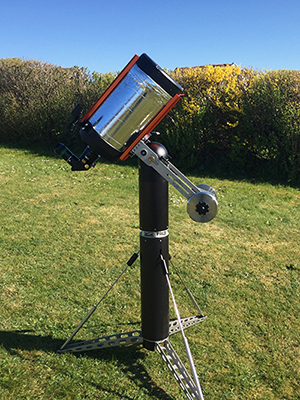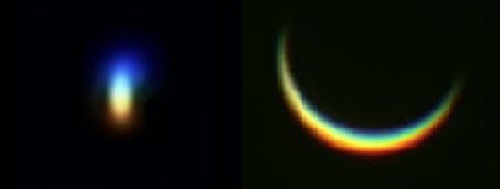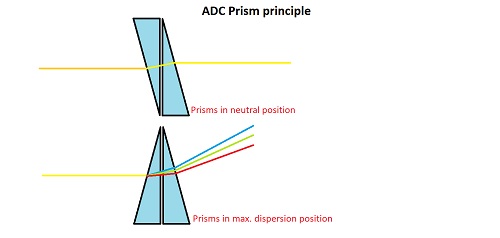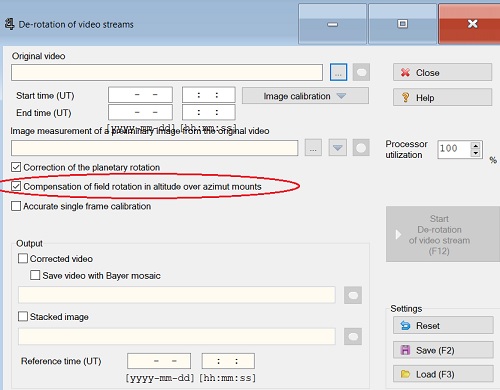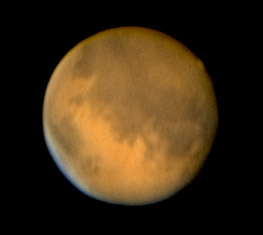
When observing and imaging the moon, the sun and the planets you need a mount that can track the object fairly precise. Generally speaking you can use either an Alt-Az mount or an polar aligned mount (GEM or fork). Here I will look at how an Alt-Az mount can be used and how it compares to a polar aligned mount for this kind of observations. It is important to remember that an Alt-Az mount is not necessarily (even though it often is so) of a lower production quality than a polar aligned mount.
Setting up for planet observations
Setting up and Alt-Az mount is faster and easier than setting up an polar aligned mount. The basic steps are:
- Setup the tripod/pier and mount head
- no leveling needed
- no polar alignment needed
- Install and balance the telescope
- only one axis to balance
- Slew to the object and start the tracking
- align on just one object
- can be done as soon as the planet becomes visible in the twilight – or the sun in daylight
On all aspects easier than using a polar aligned mount.
Tracking the planet all night
As soon as the mount has been pointed at the object, it can begin to track the object. During the observations you will experience the following:
- Eyepiece will stay in the same good angle for observations all night long. This also makes the use of “Atmospheric dispersion devices” easier as they have to be adjusted horizontally only once (see more below)
- It is possible to track an object all night without the need for performing meridian flip
- Field rotation will be in action but will not be visible either visual or photographic (see below for details)
Using an Atmospheric dispersion corrector for Planet observations
In these years Jupiter and Saturn are far south in the sky placing them very low in the sky for northern observers. It will be like that for some years to come, so it might be a good idea to consider using an Atmospheric Dispersion Corrector.
Atmospheric dispersion is a result of the earth atmosphere acting like a huge prism. It means light of different colors will be bend differently when passing through the Atmosphere. When looking at a star or Venus low in the sky this color separation is obvious.
The dispersion effect is always vertical – perpendicular to the horizon. Therefor this effect will stay in the same angle in the FOV of an Alt-Az mounted telescope – opposite to a polar aligned telescope. This splitting of the colors ruins the picture we see in the telescope. The lower the altitude of the object the worse this gets. Luckily there is a tool that can decrease (not remove) this effect, improving what we see quite a bit.
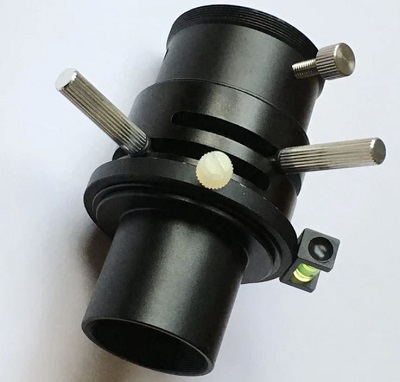
An Atmospheric Dispersion Corrector (ADC) works by introducing an adjustable prism in the telescope light pass that makes the opposite bending of the light to what happens in the earth atmosphere. In other words it brings the colors back in order. As the magnitude of the dispersion depends on the object altitude the prism needed to correct for this must be adjustable. In most ADC units this is achieved by having a split prism with two parts that can be rotated relative to each other.
When using an ADC the principle is:
- Rotate the unit in the focuser until prism correction direction is vertical (on the ZWO ADC unit shown above a small bubble level helps)
- Looking at the planet in the eyepiece or on the screen, adjust the correction factor until the best correction is seen
- Once in a while it is necessary to re-adjust the unit because the object moves
- The vertical angle must be adjusted regularly if the telescope is mounted on a polar aligned mount. If the telescope is mounted on an Alt-Az mount this is not necessary.
- The correction factor must be adjusted as the object altitude changes.
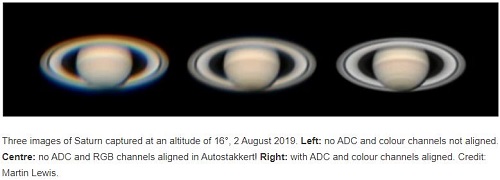
Field rotation – and the influence on planetary imaging
Above we have seen that using an Alt-Az mount for planetary observations has a number of advantages over a polar aligned mount. But as you perhaps know Alt-Az mounts results in field rotation when tracking an object over time. Learn about field rotation here
Max acceptable field rotation between sub frames to be stacked
First we look at what kind of angular rotation we can allow between the first and the last frame in the video clip we take. The two largest planets Jupiter and Saturn has an apparent diameter of around 45 ” (for Saturn this is the rings). If we work with a camera resolution of 0.2″/pixel the math will look like this:
So this means that a field rotation of 0.5 degree will move a point on the edge of the planet 0.2 arc-second. For Mars this will be 1 degree because the apparent diameter is about the half.
How long time can you image keeping field rotation out of scope
The size or speed of the field rotation depends on the observers latitude on Earth and the objects Azimut and Altitude. It is possible to make precise calculations of this but to keep it simple I have prepared a table giving the needed information:
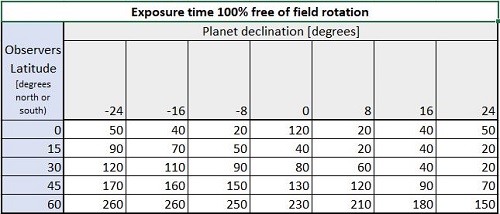
Reading the table:
- In the left column find the latitude closest to your location
- In the upper row find the declination closest to matching the planets declination
- If you are on a southern latitude select the declination with the opposite number of what it is.
- Read the exposure time in the selected cell.
Important comments:
- The time given is absolutely minimum. In most cases you can expose longer time.
- If you live north of latitude 45 you can always image well over a minute. This is already the limit for Jupiter due to the planets own rotation (0.2″ is rotated in 50 secs).
- If you observe from near equator, the planet can get close to zenith. A “dead zone” of 5 degrees radius has been taken into account.
For the expert imager there is a perfect solution to eliminate field rotation completely
If you are a really critical planetary imager you might want to expose for longer intervals than what is shown in the table above. If you do that you can use the WinJUPOS program to eliminate field rotation. WinJUPOS is mainly known for it’s capacity to de-rotate the planets own rotation to allow for longer total exposure times. But in the same workflow WinJUPOS can de-rotate the field rotation.
So the sky is the limit – almost.
